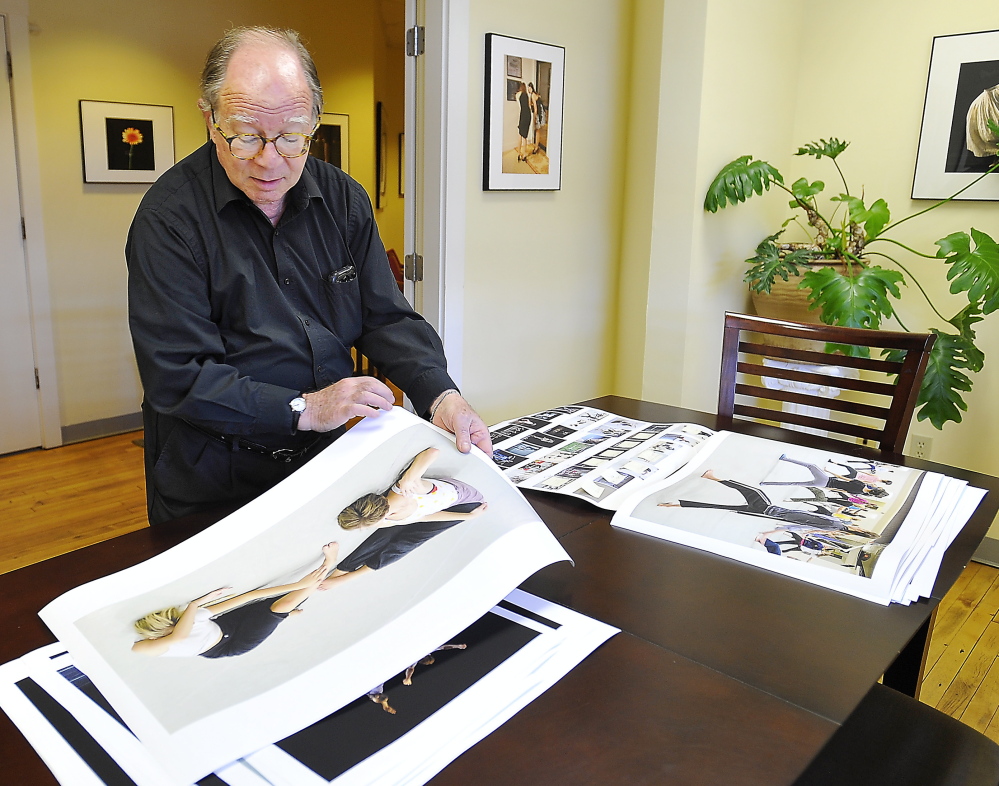(The Maine Sunday Telegram periodically will interview artists of all kinds about how they work and what inspires them. This is the first installment in the Work of Art series.)
Each summer since 2005, Portland photographer Arthur Fink has taken up residence at the Bates Dance Festival in Lewiston. He shoots about 10,000 photos of dancers who travel from across the country and around the world to study with some of the finest choreographers and teachers of modern dance.
He introduces himself at the beginning of the festival, then morphs into near anonymity. If he does his job well, Fink blends into the walls. “I walk into the studio, and most of them barely see me,” he says.
Each night, Fink posts photos he shot during the day, allowing dancers to see themselves as he sees them.
And each summer, he mounts an exhibition of photos that he took the previous year. Three dozen images are on view at Fireplace Lounge at New Commons on the Bates College campus through Aug. 9.
The photo exhibition kicks off the public portion of the festival, which begins this week with performances by Prometheus Dance. Also on the schedule this year are Camille A. Brown & Dancers, David Dorfman Dance, and Vincent Mantose|Yin Mei.
Hooked: He was working as a commercial photographer and a friend suggested he photograph a dancer to create a visual element for his business card. He did and found it to be a “soul-searching experience.”
“I didn’t like marketing commercial photography, so I left that. But this haunted me.” He asked Laura Faure, director of the Bates festival, if he could photograph there. She said no – she didn’t want the distraction. The next year, she changed her mind.
“I spent the day photographing and stayed up half the night making contact sheets and came in the next day with them, and the dancers were fascinated with how I saw them. Most of the photos were not the straight-forward shots. I wasn’t taking pictures. I was taking images.”
The difference: “I’m not just showing them what I saw. I’m showing them what I felt.”
On how he works: “I pretty much have free range to shoot anywhere.” He photographs classes and rehearsals, but prefers working without an audience.
“I feel I am a little bit of a reporter. I have access to this, and it’s a story I want to tell. And it’s the story of the dance you don’t see. You see the beautiful creation, costumes and lights, and you don’t notice that it was two fellows who tripped over each other and said, ‘There’s something interesting in that. Let’s work on that.'”
Year after year: “It’s a deeply spiritual experience. Being in the studio as dance is created is like being in a delivery room as children are being born.”
Looking back: “I will learn something when I look at my own work (from past years’ festivals). Part of it is dismal. ‘Arthur, what were you looking at? These are vacuous, thin images.’ But others really excite me. It’s like reading a journal. You remember the moments.”
For the audience: The festival is “an incredible gift. People in Maine may not know much about it, but dancers around the world know about it. I point out that it’s many things: A school for serious dance and a source for performances. There are also amazing lecture-demos where the artists talk about their creative process. There are foreign artists invited to create work, and there’s an amazing children’s program that I wish I had when I was a child. That’s the inventory. It’s not a down-home funky little thing. The best of the best come here.”
Send questions/comments to the editors.




Success. Please wait for the page to reload. If the page does not reload within 5 seconds, please refresh the page.
Enter your email and password to access comments.
Hi, to comment on stories you must . This profile is in addition to your subscription and website login.
Already have a commenting profile? .
Invalid username/password.
Please check your email to confirm and complete your registration.
Only subscribers are eligible to post comments. Please subscribe or login first for digital access. Here’s why.
Use the form below to reset your password. When you've submitted your account email, we will send an email with a reset code.